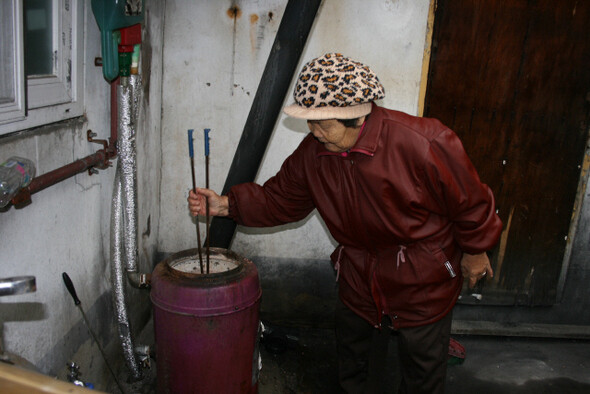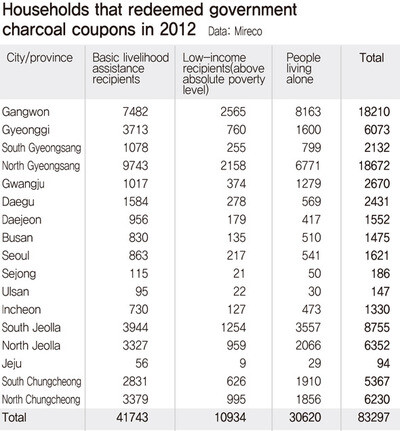hankyoreh
Links to other country sites 다른 나라 사이트 링크
[Feature] Many years later, charcoal is still the “people’s fuel” in Korea

By Kim Gi-seong, south Gyeonggi correspondent
Just thirty years ago, coal cartridges were the “people’s fuel.” These days, they have been replaced by gas and oil, leaving them mostly a fading memory. But some 200,000 struggling households in South Korea still depend on them to get through the winter cold. The worse the economy, and the fiercer the chill, the more the impoverished class relies on coal cartridges to stay warm.“Height 14.2 cm, diameter 15 cm, weight 3.6 kg, 22 holes, 4,600 kcal, average of 4.5 per day per family, costing 500 to 600 won (US$0.47-0.57).” Though forgotten to many South Koreans today, these specifications are still familiar to some.
The day was Dec. 19, in a flophouse neighborhood behind the high rises of Seongnam, Gyeonggi Province. Inside the alleyways, which are barely wide enough for two people to pass each other, the stinging smoke of the cartridges fills the nose. Inside the houses crowded along the roads, around a dozen families are struggling through the bitter cold. Boiler stacks are hung precariously in front of the doors, as if about to collapse at any moment.
Plagued with lower back problems, Kim Young-suk, 84, uses a baby carriage to travel around. She listlessly set the coal tongs down in front of the coal boiler. “I don’t have the strength to change the cartridge right now,” she said. Her house, measuring just over 6.6 square meters, was quite chilly, but Kim chose not to burn a cartridge.
“I can only burn three of them a day if I’m going to get through the winter,” she said. “I’ve gotta save.”

She pointed to the house next door. “Ever since the owner there passed away a month ago, we haven’t had to deal with that sour, nasty coal smell,” she said.
The figures commonly reported for South Korea show a per capita gross national income of US$24,000, a total of 19 million registered automobiles, 36 million smartphone users. But for the past two years, the demand for coal cartridges among the country’s poor has held steady.
As recently as the early 1980s, they were known as “black jewels,” heating houses on every block. During the winter, side streets of cities were coated in ash. Many who use oil and gas today to meet their needs don’t remember, but a lot of people have no choice but to depend on coal cartridges to make it through the fiercely winter cold. Critics have blasted coal as a dangerous option that spew toxic gases, most notably carbon monoxide. But the poor are still grateful to have something to thaw their freezing feet.
An examination of Mine Reclamation Corporation (MRC) figures on coal coupon disbursement on Dec. 29 showed 83,297 households receiving 14.1 billion won (US$13.4 million) in coupons in 2012. This was down slightly from 14.2 billion won (US$13.5 million) for 88,752 households in 2010 and 15.1 billion won (US$14.3 million) for 89,172 households in 2011.
The coupons are a kind of heating subsidy offered by the MRC since 2008 to lower the burden on households that use coal for heating and don’t have the option of switching to more expensive fuels. Recipients include low earners (basic livelihood assistance recipients and the “quasi-poverty” class) and “excluded segments” such as elderly people living alone and migrant households.
The MRC estimates that around 200,000 people depend on the coupons to get through the winter.
At a wholesale coal cartridge seller in Suwon, Gyeonggi Province, the owner, known as Kim, has had a lot of customers lately. Kim provides wholesale and retail sales for 8,000 cartridges that are shipped in around 4 or 5 o’clock every morning from a factory in South Chungcheong Province. Late night deliveries go to two or three coal sellers, who are usually struggling with short supplies.
“One cartridge costs 500 to 600 won, so a lot of them are sold for ovens for struggling families and heaters in small stores,” Kim explained.
Some coal cartridges are supplied through volunteer groups. Last year, the National Charcoal Bank Association, chaired by Heo Gi-bok, supplied 3.2 million donated cartridges to struggling families. This year, the target was adjusted down to 3 million. Its problem is that it depends chiefly on support from companies and public enterprises that are typically sensitive to economic and budget conditions.
“A nationwide demand census found 160,000 households this year that need charcoal help,” said the association’s secretary-general Sim Mi-ae.
“But with each family needing about 1,000 cartridges between October and March of next year, it’s not clear whether we can meet that goal, business conditions being what they are,” she added.
Sim made a call for additional donations.
“Lots of people think coal is only really needed in November and December, but it‘s also absolutely needed from January to March,” she said.
With 200,000 households around the country relying on cartridges, accidents have become a regular occurrence. At around 6:30 am on Dec. 22, a family of four was found poisoned by fumes at their home in the Sajik neighborhood of Cheongju, North Chungcheong Province. They were taken to hospital, where the father, a 59-year-old man named Kim, died of the effects. His wife, a 50-year-old from the Philippines, and two daughters, aged 15 and 16, were rescued but face bleak prospects with the family breadwinner gone.
The investigation found that the Kim family went to sleep with a charcoal oven lit in their living room, hoping to reduce their heating bill when the winter cold came early. Another family in the neighborhood, a couple in their seventies, was killed by poisoning from coal fumes in their house on Oct. 30.
The North Chungcheong Fire Service Headquarters reported at the time that emergency services had been dispatched for over 100 instances of coal fume poisoning in the region over the previous two years, with 48 cases in 2011 and 54 in 2012. The kinds of poisoning cases that once filled the Social News pages of newspapers are still happening today. The city of Cheongju has responded by inspecting 1,722 households that have recently used cartridges, checking for cracks in the boiler and case or gaps in the exhaust, installing and running ventilators, and rigging up alarms.

According to Korea Coal Corporation data, consumption of anthracite for “private use” - the kind used to make coal cartridges - dropped every year between 2008 and 2011, from 2.28 million to 1.82 million tons. In 2012, the trend reversed, with consumption reaching 1.83 million tons. In 2013, it is estimated to have grown to 1.89 million tons. The increased demand is believed to owe to a combination of the early onset of cold weather and poor economic conditions.
South Korea has five active coal mines, including ones at Taebaek and Samcheok in Gangwon Province and Hwasun in South Jeolla Province. There were as many as 400 charcoal factories in the 1960s, with only 47 nowadays: 12 in North Gyeongsang Province, nine in Gangwon, six in North Chungcheong, three each in Daejeon and Daegu, two each in South Chungcheong and North and South Jeolla, and one in Gyeonggi.
“Poor people recognize that charcoal is dangerous, but it’s also the most efficient energy source out there - it’s cheap and it keeps them warm,” said Byeon Chang-heum, a professor of public administration at Sejong University and advisory committee member for the foundation Welfare State Society.
“Instead of just supplying coal, we need a change in policy, with new, macro-level measures to enable the use of alternative energies,” Byeon continued. “The charcoal energy problem has to be addressed as a residential welfare issue with a public service aspect.”
In “I Ask You,” the poet Ahn Do-hyun wrote, “Don’t just kick the coal dust / Haven’t you ever been a person who burned for someone?” In the winter of 2014, those 3.6-kilogram “black jewels” are still keeping the cold away from South Korea’s poor.
Please direct questions or comments to [english@hani.co.kr]

Editorial・opinion
![[Column] Has Korea, too, crossed the Rubicon on China? [Column] Has Korea, too, crossed the Rubicon on China?](https://flexible.img.hani.co.kr/flexible/normal/500/300/imgdb/original/2024/0419/9317135153409185.jpg) [Column] Has Korea, too, crossed the Rubicon on China?
[Column] Has Korea, too, crossed the Rubicon on China?![[Correspondent’s column] In Japan’s alliance with US, echoes of its past alliances with UK [Correspondent’s column] In Japan’s alliance with US, echoes of its past alliances with UK](https://flexible.img.hani.co.kr/flexible/normal/500/300/imgdb/original/2024/0419/2317135166563519.jpg) [Correspondent’s column] In Japan’s alliance with US, echoes of its past alliances with UK
[Correspondent’s column] In Japan’s alliance with US, echoes of its past alliances with UK- [Editorial] Does Yoon think the Korean public is wrong?
- [Editorial] As it bolsters its alliance with US, Japan must be accountable for past
- [Guest essay] Amending the Constitution is Yoon’s key to leaving office in public’s good graces
- [Editorial] 10 years on, lessons of Sewol tragedy must never be forgotten
- [Column] A death blow to Korea’s prosecutor politics
- [Correspondent’s column] The US and the end of Japanese pacifism
- [Guest essay] How Korea turned its trainee doctors into monsters
- [Guest essay] As someone who helped forge Seoul-Moscow ties, their status today troubles me
Most viewed articles
- 1[Column] The clock is ticking for Korea’s first lady
- 2Samsung barricades office as unionized workers strike for better conditions
- 3After 2 months of delayed, denied medical care, Koreans worry worst may be yet to come
- 4[Column] Has Korea, too, crossed the Rubicon on China?
- 5All eyes on Xiaomi after it pulls off EV that Apple couldn’t
- 6[Correspondent’s column] In Japan’s alliance with US, echoes of its past alliances with UK
- 7US overtakes China as Korea’s top export market, prompting trade sanction jitters
- 8Hong Se-hwa, voice for tolerance whose memoir of exile touched a chord, dies at 76
- 9[Editorial] When the choice is kids or career, Korea will never overcome birth rate woes
- 10[Photo] Smile ambassador, you’re on camera